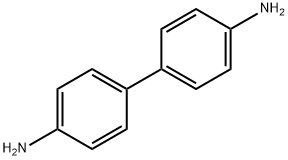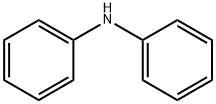Aniline standard for water analysis , Analyticalstandard, 0.816-1.96mg/Linwater (after dilution) , 62-53-3
Synonym(s):
Aminobenzene, Phenylamine, Benzenamine;Aniline
CAS NO.:62-53-3
Empirical Formula: C6H7N
Molecular Weight: 93.13
MDL number: MFCD00007629
EINECS: 200-539-3
PRODUCT Properties
| Melting point: | -6 °C (lit.) |
| Boiling point: | 184 °C (lit.) |
| Density | 1.022 g/mL at 25 °C (lit.) |
| vapor density | 3.22 (185 °C, vs air) |
| vapor pressure | 0.7 mm Hg ( 25 °C) |
| refractive index | n |
| Flash point: | 76 °C |
| storage temp. | 2-8°C |
| solubility | water: soluble |
| form | Liquid |
| pka | 4.63(at 25℃) |
| color | APHA: ≤250 |
| Specific Gravity | 1.021 |
| Odor | Sweet, amine-like odor detectable at 0.6 to 10 ppm |
| Relative polarity | 0.42 |
| PH | 8.8 (36g/l, H2O, 20℃) |
| PH Range | 8.1 |
| explosive limit | 1.2-11%(V) |
| Water Solubility | 36 g/L (20 ºC) |
| Merck | 14,659 |
| BRN | 605631 |
| Henry's Law Constant | 1.91 at 25 °C (thermodynamic method-GC/UV spectrophotometry, Altschuh et al., 1999) |
| Exposure limits | TLV-TWA skin 2 ppm (~8 mg/m3) (ACGIH),
5 ppm (~19 mg/m3) (MSHA, OSHA, and
NIOSH); IDLH 100 ppm (NIOSH). |
| Dielectric constant | 7.8(0℃) |
| Stability: | Stable. Incompatible with oxidizing agents, bases, acids, iron and iron salts, zinc, aluminium. Light sensitive. Combustible. |
| LogP | 0.900 |
| Surface tension | 47.9mN/m at 298.15K |
| CAS DataBase Reference | 62-53-3(CAS DataBase Reference) |
| IARC | 2A (Vol. 27, Sup 7, 127) |
| NIST Chemistry Reference | Aniline(62-53-3) |
| EPA Substance Registry System | Aniline (62-53-3) |
Description and Uses
First produced in 1826 by Otto Unverdorben through destructive distillation of indigo, the first industrial use was as a purple dye, Mauveine, formulated by William Henry Perkin accidentally in an attempt to isolate quinone. The name aniline was given in deference to the indigoyielding plant, Indigofera suffruticosa, commonly named anil.
Aniline is used in the manufacture of dyes,pharmaceuticals, varnishes, resins, photo graphic chemicals, perfumes, shoe blacks,herbicides, and fungicides. It is also usedin vulcanizing rubber and as a solvent. Itoccurs in coal tar and is produced from thedry distillation of indigo. It is also producedfrom the biodegradation of many pesticides.Aniline is a metabolite of many toxic com pounds, such as nitrobenzene, phenacetin,and phenylhydroxylamine.
Safety
| Symbol(GHS) |     GHS05,GHS06,GHS08,GHS09 |
| Signal word | Danger |
| Hazard statements | H301+H311+H331-H317-H318-H341-H351-H372-H410 |
| Precautionary statements | P273-P280-P301+P310-P302+P352+P312-P304+P340+P311-P305+P351+P338 |
| Hazard Codes | T,N,F |
| Risk Statements | 23/24/25-40-41-43-48/23/24/25-50-68-48/20/21/22-39/23/24/25-11 |
| Safety Statements | 26-27-36/37/39-45-46-61-63-36/37-16 |
| OEL | TWA: None ppm |
| RIDADR | UN 1547 6.1/PG 2 |
| WGK Germany | 2 |
| RTECS | BW6650000 |
| F | 8-9 |
| Autoignition Temperature | 615 °C |
| TSCA | Yes |
| HS Code | 2921 41 00 |
| HazardClass | 6.1 |
| PackingGroup | II |
| Hazardous Substances Data | 62-53-3(Hazardous Substances Data) |
| Toxicity | LD50 orally in rats: 0.44 g/kg (Jacobson) |
| IDLA | 100 ppm |



